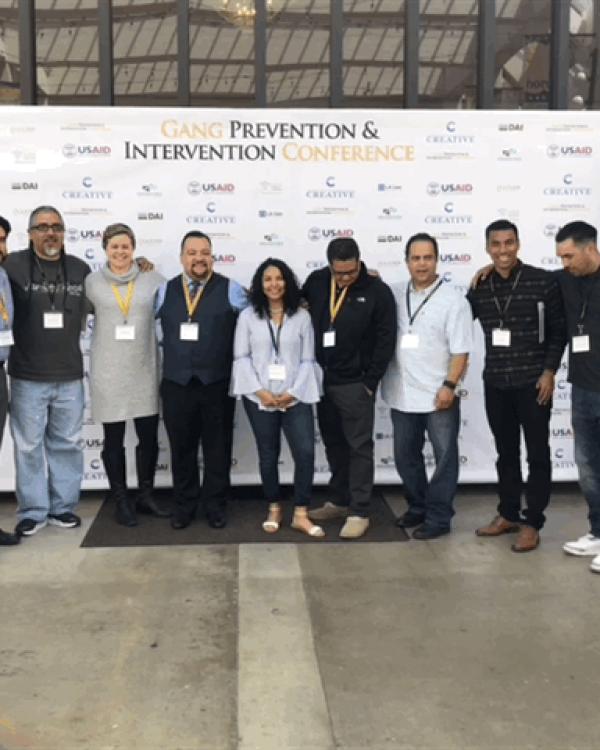
Many of the Task Force collaborators (l-r): Ricardo Venegas, Neighborhood and Outreach Services Coordinator, City of Santa Barbara; Ismael Huerta, Youth Outreach Worker, Santa Barbara Unified School District; Jill Sharkey, Department of Counseling, Clinical, and School Psychology, UC Santa Barbara; Saul Serrano, Coordinator, South Coast Task Force on Youth Safety; Alejandra Cortes, Youth Outreach Worker, Santa Barbara Unified School District; Cesar Arroyo, Program Manager, Community Action Commission; Joe Talaugon, Deputy Probation Officer, Santa Barbara Probation; Ivan Luna, Youth Service Specialist, La Cumbre Junior High School
Xavier Escamilla
Community Action Commission
Dr. Jill Sharkey of UC Santa Barbara’s Gevirtz School and her colleagues affiliated with the South Coast Task Force on Youth Safety traveled to the 7th Annual Gang Prevention & Intervention Conference on May 7th and 8th at Carson Community Center. Through speakers, panel discussions, breakout sessions, and meetings, the conference focused on Collaborative Approaches & Comprehensive Solutions to Violence. The sold out event included an extremely diverse group of practitioners from the cities and countries most impacted by gang-related violence and crime including Chicago, Seattle, Los Angeles, New York, Providence, London, El Salvador, and Honduras.
The group was briefed on the most innovative and comprehensive approaches to violence prevention and intervention happening around the world. Keynote speakers Dr. David Kennedy from John Jay College and LAPD Chief Charlie Beck provided a historical perspective on how much the solution to violence has evolved over the past 30 years. Sessions provided details about various approaches including the comprehensive strategy used by The City of Los Angeles Mayor’s Office of Gang Reduction and Youth Development (GRYD), which implements a rigorous research feedback loop to inform continuous improvement of collaborative and coordinated efforts to reduce and eliminate violence.
During the conference, Dr. Sharkey and her colleagues—led by Saul Serrano, Task Force Coordinator—met with the California Cities Violence Prevention Network to share progress and emerging issues as well as to shape the future of the effort. Moderated by Jack Calhoun (Senior Consultant U.S. Department of Justice and Development Service Group, Inc., for National Forum on Youth Violence Prevention), the meeting focused on information sharing between cities (Los Angeles, Monterey, Gilroy, San José, Santa Rosa, Salinas, Stockton, Oxnard, Santa Maria, and the South Coast) about current barriers and innovations in their violence prevention work. The group also discussed strategies for policy and practice advocacy at the state level.
The Task Force is a partnership between Carpinteria, Goleta, and Santa Barbara and Santa Barbara County. Dr. Sharkey noted, “Our team reflected that as much as we learned, we were also able to share successes in our community. The conference helped us recognize our community is at the forefront of practice in several ways including their work on racial and ethnic disparities, implicit bias, human trafficking, and the impacts of trauma and mental health on violence. We enjoyed the connections we made with other professionals and ourselves to rejuvenate our work to prevent youth violence in Santa Barbara County.”
Jill Sharkey is faculty in the Department of Counseling, Clinical, and School Psychology. This position involves teaching, coordinating the school psychology credential program, mentoring students, and modeling the scientist-practitioner program philosophy with an active applied research program. Sharkey’s research centers on promoting student engagement for all children and primarily for children who have experienced a variety of personal, family, and community risk factors. In particular, she is focused on understanding optimal family, school, and community response to youth at risk. Her recent contracts and grants have included examining school response to youths at-risk for gang involvement, innovation in juvenile justice response to females on probation, and evaluation of reentry services to promote positive outcomes for probationers.
Dr. Sharkey serves on many local community groups to protect the rights of and enhance services to youth at-risk. She is an elected member of the Juvenile Justice Coordinating Council, which determines juvenile justice policy and standards for Santa Barbara County. She also serves as an Executive Committee Member and Strategy Team Member on the South Coast Task Force for Youth Gangs, which is a group of community leaders that meets monthly to improve services and outcomes for youth in gangs or who are at-risk for joining gangs. One of her goals with these groups is to push the community to work towards common measurable goals and to develop a method of data sharing across agencies to facilitate service delivery to youth.